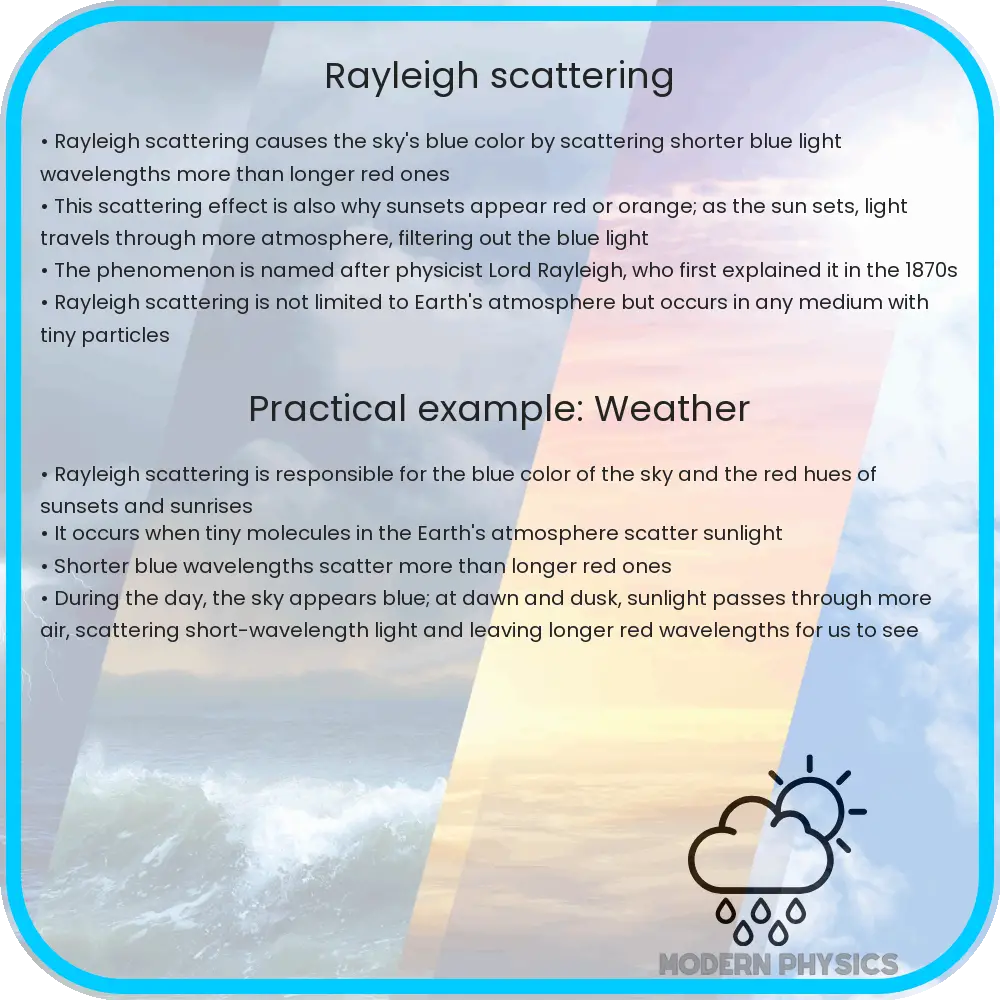Explore the cause, effect, and optical principles of Rayleigh Scattering, the phenomenon behind the blue sky and colorful sunsets.

Understanding Rayleigh Scattering: The Phenomenon Behind The Blue Sky
Rayleigh Scattering is a fundamental concept in optics that explains why the sky appears blue and the sunset red. It involves the scattering of light by particles that are much smaller than the wavelength of light itself. This scattering is named after Lord Rayleigh, who first described it in the 19th century. The principle underlying this phenomenon is crucial in various fields, including astronomy, meteorology, and even telecommunications.
Cause of Rayleigh Scattering
The cause of Rayleigh Scattering lies in the interaction between light and the molecules of the atmosphere. When sunlight enters the Earth’s atmosphere, it encounters air molecules and small particles. These particles are much smaller than the light’s wavelength, leading to the scattering of light in different directions. Notably, shorter wavelengths (blue and violet light) scatter more efficiently than longer wavelengths (red light). This differential scattering is due to the 1/λ4 dependence of Rayleigh scattering, where is the wavelength of the incident light.
Effect of Rayleigh Scattering
The most observable effect of Rayleigh Scattering is the color of the sky. During the day, when the sun is high in the sky, blue light is scattered in all directions, making the sky appear blue. At sunrise and sunset, the sun’s light passes through a greater thickness of the Earth’s atmosphere, scattering short wavelengths and allowing more red and yellow light to reach our eyes. This phenomenon not only paints the sky with beautiful colors but also influences the optical properties of the atmosphere.
Optical Principles Behind Rayleigh Scattering
The optical principles of Rayleigh Scattering are grounded in the electromagnetic theory of light. Light, as an electromagnetic wave, induces a dipole moment in the molecules it encounters. This dipole moment, in turn, radiates light in different directions, a process described by classical electromagnetism. The intensity of scattered light is inversely proportional to the fourth power of the wavelength, which explains why the sky predominantly scatters blue light. This principle is not only pivotal in understanding atmospheric optics but also in the design of optical instruments that minimize unwanted scattering.
Applications and Implications of Rayleigh Scattering
Rayleigh Scattering has implications beyond the aesthetic beauty of the sky. It plays a significant role in the transmission of radio waves, particularly in the design of antennas and understanding the propagation of signals through the atmosphere. Moreover, it is crucial in the study of the Earth’s atmosphere, aiding scientists in understanding the composition and density of air at various altitudes. Rayleigh Scattering is also utilized in lidar (Light Detection and Ranging) technology to measure atmospheric parameters and to detect pollutants.
Furthermore, this phenomenon has applications in astronomy, where it helps explain the reddish appearance of the moon during a lunar eclipse and the blue hue of distant planets observed from Earth. By analyzing the scattering of light in planetary atmospheres, astronomers can infer the composition and physical conditions of those environments.
Challenges and Considerations
Despite its utility, Rayleigh Scattering presents challenges in optical systems, such as telescopes and cameras, where it can contribute to the blurring of images. Engineers and designers must consider this effect when developing high-precision instruments, often employing filters and corrective techniques to mitigate unwanted scattering. Similarly, in telecommunications, understanding and managing the scattering of light is vital for optimizing the performance of fiber optic cables and ensuring the clarity of transmitted signals.
Conclusion
Rayleigh Scattering is a fascinating optical phenomenon with profound implications across a wide range of scientific disciplines. From painting the sky with vibrant colors to influencing the design of cutting-edge technology, its impact is both ubiquitous and profound. By elucidating the cause and effects of Rayleigh Scattering, we gain deeper insights into the natural world and our ability to harness light for human benefit. As research continues to unravel the complexities of light-matter interactions, the principles of Rayleigh Scattering will undoubtedly remain at the forefront, guiding future innovations in science and technology.
